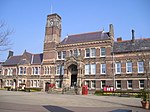St Helens Central railway station (Great Central Railway)
Disused railway stations in St Helens, MerseysideFormer Great Central Railway stationsPages with no open date in Infobox stationRailway stations in Great Britain closed in 1952Railway stations in Great Britain opened in 1900 ... and 1 more
Use British English from December 2017

St Helens Central (GCR) railway station served the town of St Helens, England with passenger traffic between 1900 and 1952 and goods traffic until 1965. It was the terminus of a branch line from Lowton St Mary's.
Excerpt from the Wikipedia article St Helens Central railway station (Great Central Railway) (License: CC BY-SA 3.0, Authors, Images).St Helens Central railway station (Great Central Railway)
Birchley Street,
Geographical coordinates (GPS) Address Nearby Places Show on map
Geographical coordinates (GPS)
| Latitude | Longitude |
|---|---|
| N 53.4553 ° | E -2.7371 ° |
Address
Birchley Street
WA10 1HT , Ravenhead
England, United Kingdom
Open on Google Maps











